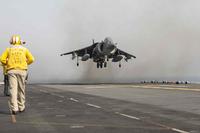 Some of the same technologies that the U.S. military used to kill Abu Musab al-Zarqawi are playing a critical role in Israel's new campaign against Hezbollah. The Israeli air force has brought to bear strike aircraft armed with laser- and satellite guided bombs and toting sophisticated targeting pods. The mission: sever communications links to Lebanon -- depriving the terrorist network of foreign support -- and to ensure that captured Israeli soldiers are not sneaked out of the country.
Some of the same technologies that the U.S. military used to kill Abu Musab al-Zarqawi are playing a critical role in Israel's new campaign against Hezbollah. The Israeli air force has brought to bear strike aircraft armed with laser- and satellite guided bombs and toting sophisticated targeting pods. The mission: sever communications links to Lebanon -- depriving the terrorist network of foreign support -- and to ensure that captured Israeli soldiers are not sneaked out of the country. Since Wednesday, Israeli warplanes have systematically bombed roads, bridges, television and radio stations and the runways at the Beirut airport. These attacks have effectively isolated Lebanon at the price of around 100 Lebanese deaths plus many injuries (see picture). In light of the swift and devastating nature of the air campaign, that death toll is surprisingly low. But then, considering that Hezbollah has no air defenses to speak of -- and that all the world is watching -- in this conflict the Israeli air force's greatest enemy is itself. It must achieve its operational goals with minimal civilian deaths to avoid turning world opinion against Israel.
Since Wednesday, Israeli warplanes have systematically bombed roads, bridges, television and radio stations and the runways at the Beirut airport. These attacks have effectively isolated Lebanon at the price of around 100 Lebanese deaths plus many injuries (see picture). In light of the swift and devastating nature of the air campaign, that death toll is surprisingly low. But then, considering that Hezbollah has no air defenses to speak of -- and that all the world is watching -- in this conflict the Israeli air force's greatest enemy is itself. It must achieve its operational goals with minimal civilian deaths to avoid turning world opinion against Israel.
That means accurate targeting and precision weapons. Most of the communications targets are static ones that Israel mapped out years ago, using aerial reconnaissance -- as well as signals and human intelligence. So figuring out what to bomb isn't hard. Hitting the targets accurately -- without civilian casualties -- is. And with airport terminals, bridges and highways teeming with local civilians and foreign tourists, the job is even tougher.
Fortunately for Israel, its air force is on the cutting edge of precision weapons technology. In the 1980s, Israeli firm Rafael pioneered small targeting pods for tactical warplanes. Today, the Rafael Litening family of pods -- containing day and night sensors, a laser designator and tracker and GPS -- equips Israeli F-16s and F-15s and U.S. aircraft such as Marine Corps F/A-18s.
Israeli aircrews probably approach from medium altitude, straight and level, using the cameras in their pods to zoom in on the target. They then designate it with a laser or determine its GPS coordinates -- or both. At the optimal distance and angle, they pickle the weapon, either an Israeli Aircraft Industries laser-guided bomb or a Boeing Joint Direction Attack Munition (JDAM), which Israel has procured in quantity since 1999.
To deliver these weapons, the Israeli air force calls upon the most capable tactical jet fleet in the Middle East. The inventory includes: 25 F-15I Ra'am (essentially F-15Es)
25 F-15I Ra'am (essentially F-15Es)
11 F-15D Akef
17 F-15C Akef
8 F-15B Baz
27 F-15A Baz
102 F-16I Soufa (advanced F-16 Block 50s, some still in delivery)
75 F-16D Brakeet
52 F-16C Barak
20 F-16B Netz
90 F-16A Netz
The F-15Is and F-16Is are the most advanced strike aircraft in the Middle East, with the possible exception of the Emirates' F-16E/Fs. But the only pictures of current air operations that I've seen have shown just F-16Cs and Ds, which makes sense. The early F-16s and F-15s are best suited for air-to-air missions and the F-15Is and F-16Is are long-range strike aircraft with conformal fuel tanks, likely being held in reserve for possible action against Iran, which reportedly has troops in Lebanon and supplied the drone that damaged an Israeli patrol boat and killed four sailors on Thursday.
--David Axe
UPDATE 6:59 PM: Stratfor says that "we are now in the period preceding major conventional operations. Israel is in the process of sealing the Lebanese coast. They have disrupted Lebanese telecommunications, although they have not completely collapsed the structure. Israeli aircraft are attacking Hezbollah's infrastructure and road system. In the meantime, Hezbollah, aware it is going to be hit hard, is in a use-it or-lose-it scenario, firing what projectiles it can into Israel."
The Israeli strategy appears to be designed to do two things. First, the Israelis are trying to prevent any supplies from entering Lebanon, including reinforcements. That is why they are attacking all coastal maritime facilities. Second, they are degrading the roads in Lebanon. That will keep reinforcements from reaching Hezbollah fighters engaged in the south. As important, it will prevent the withdrawal and redeployment of heavy equipment deployed by Hezbollah in the south, particularly their rockets, missiles and launchers. The Israelis are preparing the battlefield to prevent a Hezbollah retreat or maneuver.
Hezbollah's strategy has been imposed on it. It seems committed to standing and fighting. The rate of fire they are maintaining into Israel is clearly based on an expectation that Israel will be attacking. The rocketry guarantees the Israelis will attack. Hezbollah has been reported to have anti-tank and anti-air weapons. The Israelis will use airmobile tactics to surround and isolate Hezbollah concentrations, but in the end, they will have to go in, engage and defeat Hezbollah tactically. Hezbollah obviously knows this, but there is no sign of disintegration on its part. At the very least, Hezbollah is projecting an appetite for combat. Sources in Beirut, who have been reliable to this point, say Hezbollah has weapons that have not yet been seen, such as anti-aircraft missiles, and that these will be used shortly.
UPDATE 7:20 PM: Be sure to check out Tom Barnett's take on the crisis, too; this is Iran's "form of a pre-emptive war -- well-timed and well-placed," he says.








